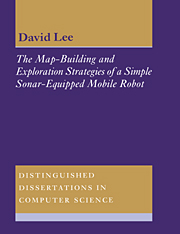 The Map-Building and Exploration Strategies of a Simple Sonar-Equipped Mobile Robot
The Map-Building and Exploration Strategies of a Simple Sonar-Equipped Mobile Robot Book contents
- Frontmatter
- Contents
- Preface
- 1 Question, Context and Method
- I Starting Points
- II System Components
- III Experiments
- 11 Experimental Evaluation
- 12 Wall-Following
- 13 The Results of Localisation
- 14 Supervised Wall-Following
- 15 Can a Human Do Any Better?
- 16 Longest Lines of Sight
- 17 Free Space Boundaries
- 18 Summary of Experimental Results
- 19 Conclusions
- 20 Directions for Further Research
- Appendix A The Feature-Map Data Structure
- Appendix B Test Rooms
- Appendix C Finding the Best-Fit Line
- Appendix D ARNE's Standard Dialogue
- Bibliography
- Index
20 - Directions for Further Research
Published online by Cambridge University Press: 05 March 2012
- Frontmatter
- Contents
- Preface
- 1 Question, Context and Method
- I Starting Points
- II System Components
- III Experiments
- 11 Experimental Evaluation
- 12 Wall-Following
- 13 The Results of Localisation
- 14 Supervised Wall-Following
- 15 Can a Human Do Any Better?
- 16 Longest Lines of Sight
- 17 Free Space Boundaries
- 18 Summary of Experimental Results
- 19 Conclusions
- 20 Directions for Further Research
- Appendix A The Feature-Map Data Structure
- Appendix B Test Rooms
- Appendix C Finding the Best-Fit Line
- Appendix D ARNE's Standard Dialogue
- Bibliography
- Index
Summary
The experience gained during the development of this thesis has suggested a number of directions in which the research could be extended. This final chapter examines these ideas under four groupings:
• Mixing planning and reactive navigation.
• Modifying the exploration method as the exploration progresses.
• Testing new sensors and new environments.
• Examining the feature map for inconsistencies.
A section is devoted to each of these areas.
20.1 Mixing Planning and Reactive Navigation
The Supervised Wall-Following strategy has shown that effective exploration can arise from a combination of reactive and model-based decisions. The application of the quality metric to maps of the ‘Walls’ environment showed that small errors in the map could lead to collisions unless the robot's movements took into account the latest information from the robot's sensors. These results suggest that it would be useful to extend the current research by implementing a navigation strategy which combines planning and reactive components.
There are clear parallels between this idea and the concept of compliance in automated assembly (McKerrow 1991, page 293). In both cases the robot uses its stored understanding of the state of the world to plan its actions, but it has to adjust its behaviour if sensory input disagrees with that understanding.
The work of Pay ton, Rosenblatt, and Keirsey (1991) is attractive in this context. They propose the use of ‘internalized plans’ which act as information resources to guide the reactive behaviour of the robot.
- Type
- Chapter
- Information
- The Map-Building and Exploration Strategies of a Simple Sonar-Equipped Mobile RobotAn Experimental, Quantitative Evaluation, pp. 201 - 204Publisher: Cambridge University PressPrint publication year: 1996
